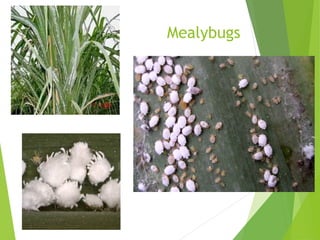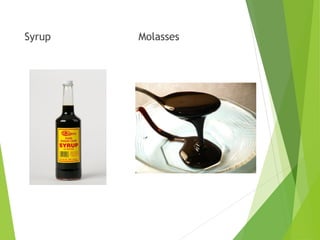Sugarcane in Malaysia
- 1. SugarcaneSugarcane FAP 2433FAP 2433 DS 102DS 102 Section ASection A
- 2. Introduction Sugarcane is the common name for a number of species belonging to the taxonomic genus Saccharum They are tall tropical southeast Asian grasses Have thick, solid, tough stems that are the chief commercial source of sugar Sugarcane is one of the most wide-spread plants in the world Found especially in warm temperate areas Most important and famous export products
- 3. Taxonomy Sugarcane is a giant grass (Poaceae) Tribe: Adropogoneae Genus, species: Saccharum officinarum L. Saccharum officinarum L. is the so called ‘noble cane’ with long, thick, heavy, juicy, and sweet stalks Other species include: 1. S. barberi, 2. S. robustum 3. S. sinese 4. spontaneum Commercial clones are typically 3-part hybrids
- 5. Stalks A leaf scar can be found at the node when the leaf drops off the plant. The buds, located in the root band of the node. The outer small leaves are in the form of scales. The outermost bud scale has the form of a hood. Normally, one bud is present on each node, and they alternate between one side of the stalk to the other. The root band also contains loosely defined rows of root primordia. When seed-cane is planted, each bud may form a primary shoot. From this shoot, secondary shoots called “tillers” may form from the underground buds on the primary shoot.
- 6. Leaf The leaf of the sugarcane plant is divided into two parts: sheath and blade, separated by a blade joint. The leaves are usually attached alternately to the nodes, thus forming two ranks on opposite sides. The mature sugarcane plant has an average total upper leaf surface of about 0.5 square meter and the number of green leaves per stalk is around ten
- 7. Root Two kinds of roots will develop from a planted seed piece. The set roots, which arise from the root band, are thin and highly branched The shoot roots, originating from the lower root bands of the shoots, are thick, fleshy and less branched. Each new tiller (shoot) will develop its own roots that eventually take over the function of the original shoot roots. This rejuvenation, governed by the periodicity of tillering, is important because it allows the plant to adjust to changing environmental conditions.
- 8. Nursery Generally sugarcane is grown by planting the seeds setts directly into the field. But some times, when the water is in short supply or the field is occupied with some other crop, buds or seed setts can be planted in polybags to raise nursery. Polybags of 10x15cm filled with soil and compost mixture (in 1:1 ratio) are arranged closely in an open space, close to water source. Scooped buds are at 1-2 cm depth. Cut sugarcane pieces with one bud can also be used for raising the nursery. Insert these cut pieces into the soil, filled bags up to the node level, keeping buds just touching the soil. Irrigate these bags twice a week. Saplings will be ready for planting in 60 days.
- 11. Stem Cutting (Commercial) Commercial sugarcane is propagated by cuttings of the stalk containing usually two or more nodes with buds. The bud, a miniature stalk with its growing point and root and leaf primordia, forms the new shoot. Seed piece contains root primordia within its root band, which develop into set roots which function until the young shoot develops its own roots.
- 12. Soil Preparation Ploughing and cultivation is essential so that a good seed bed is prepared. A higher amount of organic manures is advantageous for nursery crops for obtaining a vigorous crop. Apply 25 to 30 tonnes of FYM or cured press mud may be applied about 15 days before planting.
- 13. Sett Treatment a. Preparation of setts for planting: Take seed material from short crop (6 to 7 months age) free from pests and diseases incidence. Harvest the seed crop one day before planting to obtain higher percentage and uniform germination. Detrash the cane with hand before setts preparation. Avoid damage to buds while cutting setts. Planting material or seed cane should be free from aerial roots and splits. Change the seed material after every two to three seasons. In case if it is inevitable to use mature cane as seed, the top one-third portion can be used satisfactorily. b. Sett treatment with fungicide: The setts should be soaked in Carbendazim (1 gram in 1litre of water) d. Aerated steam treatment: Treat setts with Aerated steam at 50 o C for one hour to control primary infection of grassy shoot disease.
- 15. Detrashing Detrashing refers to removal of unwanted bottom dry and green leaves at regular intervals Detrashing should be taken up after the cane formation around 150 days after planting. Maintaining clean field Enhances air movement and enriches Co² with in the crop canopy providing an ideal micro-climate for unrestricted growth of cane More food material is made available for stalk growth Reduces the problem of infestation of several insect- pests like scales, mealy bug, white flies
- 17. Propping The operation of tying the leaves together using the bottom dry and green leaves is known as propping. It is done to check lodging of cane. Usually the trash without removing from the cane is twisted to form a sort of rope and cane stalks are tied together. This is known as trash-twist propping. Propping can be either done for each row or two rows can be brought together and tied
- 19. Fertilization Sugar cane is a heavy consumer of nutrients. Its root system is shallow and fibrous, therefore, fertigation is recommended for higher nutrient availability and use efficiency. Growth period Nitrogen (kg/ha) N Phosphorus (kg/ha) P2O5 Potassium (kg/ha) K20 Emergence and establishment 30 25 Tillering Formative phase I Formative phase II 40 100 35 25 50 10 Grand growth I 80 15 20 Grand growth II 40 Grand growth III 50 Total 250 100 170
- 20. Pest Stalk borer Termite Mealybugs
- 21. Sugarcane borer Diatraea saccharalis Larvae bore into the sugarcane stalks. Attack the stalk and tunneling by borers makes the seed piece susceptible to fungal infection. Cause a loss of stalk weight also bored internodes produce 45% less sugar Control management : 1. Trichogrammatoidea sp (biological) 2. Detrash the crop on the 150th and 210th day after planting (cultural)
- 22. Sugarcane borer
- 23. Termites Microtermes sp Can be in light soil and some in heavy soil Termite infestation caused 30-60% destruction of buds Feeding on the internal tissue until the setts or stalks are hollowed out Control management : 1. Use chlorpyriphos (chemical)
- 24. Termites
- 25. Mealybugs Saccharicoccus sacchari Nymphs and adults suck sap Reduce the vitality of the crop by excrete honey dew on which sooty mould grow, due to which internodes appear black, and cane growth is retarded. Control management : 1. Detrashing (cultural) 2. Methyl parathion 50 EC or Malathion (chemical)
- 26. Mealybugs
- 27. Disease Red rot disease Sugarcane smut disease
- 28. Red rot disease Colletotrichum falcatum (fungi) Yellowing, drying leaves Elongated red lesions on leaf midribs which may develop a straw yellow center Splitting open the stalk lengthwise reveals reddish patches of tissue interrupted by white areas Vascular tissue may be red Control Management 1. Resistant varieties (biological) 2. remove crop debris (cultural) *Fungicide uneffective
- 29. Red rot disease
- 30. Sugarcane smut disease Sporisorium scitamineum (fungi) Stunted growth of sugarcane stools Profuse production of tillers Shortened internodes Stems thin with narrow, erect leaves Black whip-like structure emerging from terminal bud Control management 1. Resistant varieties 2. Infected plants should be removed 3. Seed treatment
- 31. Smut
- 32. Harvesting Sugarcane matures in 10-12 month Different Indicators of harvesting are leaves become yellow, plants stops growing and arrows come out, cane produces metallic sounds, buds swell out and eyes start sprouting Types of harvesting 1. Manual harvesting 2. Mechanical harvesting
- 33. Manual harvesting Hand knives, cutting blade or hand axes are used for manual harvesting Requires skilled labourers as improper harvest of cane leads to loss of cane and sugar yield Sometimes area is fired before harvesting to remove the dead leaf material and some of the waxy coating. The fire burns at quite high temperatures but is over very quickly so that the cane and its sugar content are not harmed
- 34. Mechanical harvesting Sugarcane is harvested by mechanical harvester which move along the rows of cane removing the leafy tops of the cane and cutting the stalk into short pieces The field capacity of mechanical cane harvesters varies with the size (2.5 to 4 ha per day of 8 hours)
- 35. By-products Raw sugar Sugarcane Juices
- 36. Syrup Molasses
- 38. Gula Padang Terap Gula Padang Terap Sdn Bhd (GPT), a key player in Malaysia's growing sugar industry, is committed to bringing our customers only the highest-grade sucrose- based products derived from natural, wholesome sweetness. Established in 1973, GPT over the decades has not only met domestic and overseas demands for the best grade sugars, but has also dedicated itself to elevating and advancing the socio-economic status of the district of Padang Terap in Kedah Darul Aman.
- 39. Products
- 40. Malayan Sugar Manufacturing MSM Malaysia Holdings Berhad (MSM), incorporated on 10 March 2011, is Malaysia’s leading sugar producer. It was listed on the Main Market of Bursa Malaysia Securities Berhad on 28 June 2011. The company offers a variety of products ranging from white refined sugar of various grain sizes to soft brown sugar. These are marketed and sold in a variety of packaging options under two brands – “Gula Prai” and “Gula Perlis”. The Company also sells molasses, a by- product of the refining process, to distilleries and producers of ethanol, animal feed and yeast, among other products.
- 41. Products
- 42. Central Sugar Refinery Central Sugars Refinery (CSR) commenced business in 1965 under the name of "United Malay State Sugar Industries" with an initial raw melting capacity of 150 metric tonnes a day. Today, after decades of expansion and modernisation, the refinery achieves a melting capacity of 1,500 metric tonnes a day - a singular feat that can be solely attributed to the dedication and commitment of our employees. Situated at Batu Tiga, Shah Alam in Selangor with a land area of about 66,320 sq metres (16.4 acres), CSR was initially led by a group of Taiwanese investors when it was established. The major controlling stakeholders, however, were Malaysians, who comprised more than 55% of the shareholding.
- 43. PRODUCTS
- 44. Yeo Hiap Seng (Malaysia) Bhd. From its humble origins in 1900, Yeo Hiap Seng (Yeo’s) has now become synonymous with the food & beverage industry both locally and internationally. Taking root from a small little shop making soya sauce to the leading home-grown food & beverage company Having already made a name for itself in Malaysia and Singapore, Yeo’s took the bold step to establish joint ventures with several foreign companies as well as establish direct overseas operations in countries such as Indonesia, Hong Kong, China, Canada, the US and other parts of the globe.
- 45. PRODUCTS













































